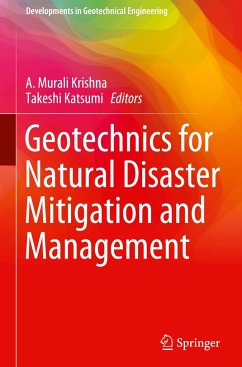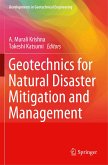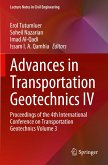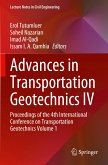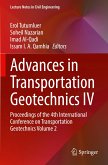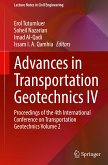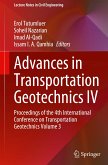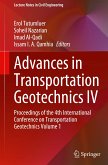Geotechnics for Natural Disaster Mitigation and Management
Herausgegeben:Krishna, A. Murali; Katsumi, Takeshi
Geotechnics for Natural Disaster Mitigation and Management
Herausgegeben:Krishna, A. Murali; Katsumi, Takeshi
- Gebundenes Buch
- Merkliste
- Auf die Merkliste
- Bewerten Bewerten
- Teilen
- Produkt teilen
- Produkterinnerung
- Produkterinnerung
This volume presents recent advances and developments taking place in geotechnical aspects of natural disaster mitigation and management. The chapters of this book are based on the invited lectures delivered by eminent researchers at the Third Indo-Japan Workshop on Geotechnics for Natural Disaster Mitigation and Management. This book will be a useful reference for academicians, researchers, practicing professionals and, especially, students of the geotechnical fraternity.
Andere Kunden interessierten sich auch für
![Geotechnics for Natural Disaster Mitigation and Management Geotechnics for Natural Disaster Mitigation and Management]() Geotechnics for Natural Disaster Mitigation and Management93,99 €
Geotechnics for Natural Disaster Mitigation and Management93,99 €![Advances in Transportation Geotechnics IV Advances in Transportation Geotechnics IV]() Advances in Transportation Geotechnics IV308,99 €
Advances in Transportation Geotechnics IV308,99 €![Advances in Transportation Geotechnics IV Advances in Transportation Geotechnics IV]() Advances in Transportation Geotechnics IV423,99 €
Advances in Transportation Geotechnics IV423,99 €![Advances in Transportation Geotechnics IV Advances in Transportation Geotechnics IV]() Advances in Transportation Geotechnics IV269,99 €
Advances in Transportation Geotechnics IV269,99 €![Advances in Transportation Geotechnics IV Advances in Transportation Geotechnics IV]() Advances in Transportation Geotechnics IV269,99 €
Advances in Transportation Geotechnics IV269,99 €![Advances in Transportation Geotechnics IV Advances in Transportation Geotechnics IV]() Advances in Transportation Geotechnics IV308,99 €
Advances in Transportation Geotechnics IV308,99 €![Advances in Transportation Geotechnics IV Advances in Transportation Geotechnics IV]() Advances in Transportation Geotechnics IV423,99 €
Advances in Transportation Geotechnics IV423,99 €-
-
-
This volume presents recent advances and developments taking place in geotechnical aspects of natural disaster mitigation and management. The chapters of this book are based on the invited lectures delivered by eminent researchers at the Third Indo-Japan Workshop on Geotechnics for Natural Disaster Mitigation and Management. This book will be a useful reference for academicians, researchers, practicing professionals and, especially, students of the geotechnical fraternity.
Produktdetails
- Produktdetails
- Developments in Geotechnical Engineering
- Verlag: Springer / Springer Nature Singapore / Springer, Berlin
- Artikelnr. des Verlages: 978-981-13-8827-9
- 1st edition 2020
- Seitenzahl: 156
- Erscheinungstermin: 2. September 2019
- Englisch
- Abmessung: 241mm x 160mm x 14mm
- Gewicht: 402g
- ISBN-13: 9789811388279
- ISBN-10: 981138827X
- Artikelnr.: 56529784
- Herstellerkennzeichnung Die Herstellerinformationen sind derzeit nicht verfügbar.
- Developments in Geotechnical Engineering
- Verlag: Springer / Springer Nature Singapore / Springer, Berlin
- Artikelnr. des Verlages: 978-981-13-8827-9
- 1st edition 2020
- Seitenzahl: 156
- Erscheinungstermin: 2. September 2019
- Englisch
- Abmessung: 241mm x 160mm x 14mm
- Gewicht: 402g
- ISBN-13: 9789811388279
- ISBN-10: 981138827X
- Artikelnr.: 56529784
- Herstellerkennzeichnung Die Herstellerinformationen sind derzeit nicht verfügbar.
Dr. A. Murali Krishna is a faculty member in Department of Civil Engineering at Indian Institute of Technology (IIT) Guwahati, since 2008. He obtained doctoral degree from Indian Institute of Science Bangalore, M.Tech degree from IIT Kanpur and B.Tech degree from Sri Venkateswara University, Tirupati. His research interests include: Earthquake Geotechnics, Geosynthetics and Ground Improvement, Site characterization and Numerical and Physical modelling of geotechnical structures. Dr. Murali Krishna supervised 7 Doctoral students and 24 Masters students. He co-authored nearly 170 publications of technical papers in international/national Journals and conference/seminar proceedings, including book chapters. He is a recipient of BRNS Young Scientist Research award, BOYSCAST fellowship and HERTAGE fellowship. Dr. Murali Krishna is an executive member of ISRM (India) and ISET. He is also a Member of TC 203 of ISSMGE, since 2011. He served Indian Geotechnical Society as an 'Executive Member' for four terms (2011-2018). Dr. Murali Krishna organised several national and international workshops and short courses. He is a reviewer for several national and international journals. Dr. Takeshi Katsumi is a Professor at the Graduate School of Global Environmental Studies (GSGES), Kyoto University, Japan. He graduated from the Department of Civil Engineering, Kyoto University, and obtained his doctoral degree from the same university in 1997. He has research interests in a variety of topics of environmental geotechnics, including waste landfills, remediation of contaminated sites, and re-use of by-products in geotechnical applications. He has received several awards including the "JSPS Prize" by the Japan Society for the Promotion of Science. He has been a member of ISSMGE Technical Committee No.215 on Environmental Geotechnics for more than 15 years, and served as the International Secretary of the Japanese GeotechnicalSociety (JGS) from 2014 to 2018.
Chapter 1: Resistance of Reinforced Gravity Type Breakwater with Steel Pipe Piles.- Chapter 2: Disaster Management in India and Characterization for Geohazards.- Chapter 3: Review of the material properties of recovered soils obtained from 2011 East Japan disaster debris for post-disaster management.- Chapter 4: The 2017 July Northern Kyushu Torrential Rainfall Disaster- Geotechnical and Geological Perspectives.- Chapter 5: Effect of fine grain fraction contents of short fiber mixed soil for mitigation of liquefaction hazards.- Chapter 6: Ground Modification Techniques to Improve Liquefaction Resistance in Indo-Gangetic Soils.- Chapter 7: Extended Application of Cement Based Grouting to Gravel/Boulder Ground Improvement.- Chapter 8: Elastic Modulus Estimation using a Scaled State Parameter in the Extended Kalman Filter.- Chapter 9: Shear Strength Behavior of Gravel-Tire Chips Mixture.- Chapter 10: Evaluation of the risk distribution of the Debris Flow Occurred Using Numerical Simulation Subjected to Rockfall.- Chapter 11: Design of Waterfront Retaining Walls Subjected to Waves and Earthquakes- A Review.- Chapter 12: Stability Evaluation of Block Reinforcement for Resilient Breakwater.- Chapter 13: Integrating Rainfall Load into Remedial Design of slopes affected by Landslides.- Chapter 14: Spatial Distribution of Strength - Comparison between Indian and Japanese Embankments.- Chapter 15: Investigation of Rainfall Induced Landslides at the Hillslopes of Guwahati Region, Assam.- Chapter 16: Significance of Drainage measures on Landslide Mitigation measures.- Chapter 17: Instability of Composite Breakwater Subjected to Earthquake and Tsunami and Its Countermeasures.- Chapter 18: Soil slope instabilities in snowy cold regions under changing climate - stability assessment and prediction methods assessment and prediction methods.
Chapter 1: Resistance of Reinforced Gravity Type Breakwater with Steel Pipe Piles.- Chapter 2: Disaster Management in India and Characterization for Geohazards.- Chapter 3: Review of the material properties of recovered soils obtained from 2011 East Japan disaster debris for post-disaster management.- Chapter 4: The 2017 July Northern Kyushu Torrential Rainfall Disaster- Geotechnical and Geological Perspectives.- Chapter 5: Effect of fine grain fraction contents of short fiber mixed soil for mitigation of liquefaction hazards.- Chapter 6: Ground Modification Techniques to Improve Liquefaction Resistance in Indo-Gangetic Soils.- Chapter 7: Extended Application of Cement Based Grouting to Gravel/Boulder Ground Improvement.- Chapter 8: Elastic Modulus Estimation using a Scaled State Parameter in the Extended Kalman Filter.- Chapter 9: Shear Strength Behavior of Gravel-Tire Chips Mixture.- Chapter 10: Evaluation of the risk distribution of the Debris Flow Occurred Using Numerical Simulation Subjected to Rockfall.- Chapter 11: Design of Waterfront Retaining Walls Subjected to Waves and Earthquakes- A Review.- Chapter 12: Stability Evaluation of Block Reinforcement for Resilient Breakwater.- Chapter 13: Integrating Rainfall Load into Remedial Design of slopes affected by Landslides.- Chapter 14: Spatial Distribution of Strength - Comparison between Indian and Japanese Embankments.- Chapter 15: Investigation of Rainfall Induced Landslides at the Hillslopes of Guwahati Region, Assam.- Chapter 16: Significance of Drainage measures on Landslide Mitigation measures.- Chapter 17: Instability of Composite Breakwater Subjected to Earthquake and Tsunami and Its Countermeasures.- Chapter 18: Soil slope instabilities in snowy cold regions under changing climate - stability assessment and prediction methods assessment and prediction methods.

